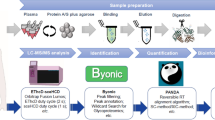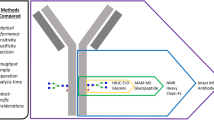Abstract
Playing an important role in a broad range of biological and pathological processes, sialylation has been drawing wide interest. The efficient sialoglycopeptides enrichment methods are therefore attracting considerable attention. In this paper, we first compared two conventional enrichment methods, lectin and TiO2, and analyzed their characteristics. Furthermore, considering the highly negatively charged nature of sialic acids, we developed a new strategy, peptide immobilized pH gradient isoelectric focusing (IPG-IEF) assisted TiO2 chromatography (PIAT), for the highly efficient enrichment of sialoglycopeptides. In this method, peptides were first separated into 24 fractions using peptide IPG-IEF. Sialoglycopeptides were relatively concentrated in low-pH fractions of the immobilized pH strips and were captured using TiO2 chromatography. As a result, 614 N-glycosylation sites were identified in 582 sialoglycopeptides within 322 sialoglycoproteins from rat liver using PIAT. To our knowledge, this work represents one of the most comprehensive sialoglycoproteomic analyses in general and exhibits the largest database of sialoglycoproteome in rat liver currently. So the new strategy introduced here exhibits high efficiency and universality in the sialoglycopeptide enrichment, and is a powerful tool for sialoglycoproteome exploration.




Similar content being viewed by others
Abbreviations
- PIAT:
-
Peptide IPG-IEF assistant TiO2 chromatography
- SAs:
-
Sialic acids
- MW:
-
Molecular weight
- pI:
-
Isoelectric point
- LC:
-
Liquid chromatography
- MS/MS:
-
Tandem mass spectrometry
- PNGase F:
-
N-glycosidase F
References
Varki, A.: Glycan-based interactions involving vertebrate sialic-acid-recognizing proteins. Nature 446, 1023–1029 (2007)
Angata, T., Varki, A.: Chemical diversity in the sialic acids and related α-keto acids: an evolutionary perspective. Chem. Rev. 102, 439–470 (2002)
Gunnar, B.: The carbohydrate groups of the submaxillary mucin. Z. Physiol. Chem. 240, 43 (1936)
Rempel, H., Calosing, C., Sun, B., Pulliam, L.: Sialoadhesin expressed on IFN-induced monocytes binds HIV-1 and enhances infectivity. PLoS One 3, e1967 (2008)
Haselhorst, T., Fleming, F.E., Dyason, J.C., Hartnell, R.D., Yu, X., Holloway, G., Santegoets, K., Kiefel, M.J., Blanchard, H., Coulson, B.S., Itzstein, M.V.: Sialic acid dependence in rotavirus host cell invasion. Nat. Chem. Biol. 5, 91–93 (2008)
Varki, A.: Nothing in glycobiology makes sense, except in the light of evolution. Cell 126, 841–845 (2006)
Bishop, J., Gagneux, P.: Evolution of carbohydrate antigens — microbial forces shaping host glycomes? Glycobiology 17, 23R–34R (2007)
Varki, A., Angata, T.: Siglecs — the major subfamily of I-type lectins. Glycobiology 16, 1R–27R (2006)
Shinya, K., Ebina, M., Yamada, S., Ono, M., Noriyuki, K., Kawaoka, Y.: Avian flu: Influenza virus receptors in the human airway. Nature 440, 435–436 (2006)
Hidari, K.I., Shimada, S., Suzuki, Y., Suzuki, T.: Binding kinetics of influenza viruses to sialic acid-containing carbohydrates. Glycoconj. J. 24, 583–590 (2007)
Hidari, K.I.P.J., Suzuki, T.: Glycan receptor for influenza virus. The Open Antimicrobial Agents Journal 2, 26–33 (2010)
Shetty, V., Nickens, Z., Shah, P., Sinnathamby, G., Semmes, O.J., Philip, R.: Investigation of sialylation aberration in N-linked glycopeptides by Lectin and Tandem Labeling (LTL) quantitative proteomics. Anal. Chem. 82, 9201–9210 (2010)
Scanlin, T.F., Glick, M.C.: Terminal glycosylation and disease: influence on cancer and cystic fibrosis. Glycoconj. J. 17, 617–626 (2000)
Gorelik, E., Galili, U., Raz, A.: On the role of cell surface carbohydrates and their binding proteins (lectins) in tumor metastasis. Cancer Metastasis Rev. 20, 245–277 (2001)
Varki, N.M., Varki, A.: Heparin inhibition of selectin-mediated interactions during the hematogenous phase of carcinoma metastasis: rationale for clinical studies in humans. Semin. Thromb. Hemost. 28, 53–66 (2002)
Borsig, L., Wong, R., Hynes, R.O., Varki, N.M., Varki, A.: Synergistic effects of L- and P-selectin in facilitating tumor metastasis can involve non-mucin ligands and implicate leukocytes as enhancers of metastasis. Proc. Natl. Acad. Sci. U. S. A. 99, 2193–2198 (2002)
Laubli, H., Stevenson, J.L., Varki, A., Varki, N.M., Borsig, L.: L-selectin facilitation of metastasis involves temporal induction of Fut7-dependent ligands at sites of tumor cell arrest. Cancer Res. 66, 1536–1542 (2006)
Ying-Chih, L., Hsin-Yung, Y., Chien-Yu, C., Chein-Hung, C., Ping-Fu, C., Yi-Hsiu, J., Chung-Hsuan, C., Kay-Hooi, K., Chong-Jen, Y., Pan-Chyr, Y., Tsui-Ling, H., Chi-Huey, W.: Sialylation and fucosylation of epidermal growth factor receptor suppress its dimerization and activation in lung cancer cells. PNAS 108, 11332–11337 (2011)
Tajiri, M., Ohyama, C., Wada, Y.: Oligosaccharide profiles of the prostate specific antigen in free and complexed forms from the prostate cancer patient serum and in seminal plasma: a glycopeptide approach. Glycobiol. 18, 2–8 (2008)
Bond, M.R., Kohler, J.J.: Chemical methods for glycoprotein discovery. Curr. Opin. Chem. Biol. 11, 52–58 (2007)
Laughlin, S.T., Baskin, J.M., Amacher, S.L., Bertozzi, C.R.: In vivo imaging of membrane- associated glycans in developing zebrafish. Science 320, 664–667 (2008)
Yang, L., Nyalwidhe, J.O., Guo, S., Drake, R.R., Semmes, O.J.: Targeted identification of metastasis-associated cell-surface sialoglycoproteins in prostate cancer. Mol. Cell. Proteomics (2011). doi:10.1074/mcp.M110.007294
Nilsson, J., Rüetschi, U., Halim, A., Hesse, C., Carlsohn, E., Brinkmalm, G., Larson, G.: Enrichment of glycopeptides for glycan structure and attachment site identification. Nat. Methods 6, 809–811 (2009)
Zeng, Y., Ramya, T.N., Dirksen, A., Dawson, P.E., Paulson, J.C.: High-efficiency labeling of sialylated glycoproteins on living cells. Nat. Methods 6, 207–209 (2009)
Tian, Y., Esteva, F.J., Song, J., Zhang, H.: Altered expression of sialylated glycoproteins in breast cancer using hydrazide chemistry and mass spectrometry. Mol. Cell. Proteomics (2012). doi:10.1074/mcp.M111.011403
Drake, P.M., Schilling, B., Niles, R.K., Braten, M., Johansen, E., Liu, H., Lerch, M., Sorensen, D.J., Li, B., Allen, S., Hall, S.C., Witkowska, H.E., Regnier, F.E., Gibson, B.W., Fisher, S.J.: A lectin affinity workflow targeting glycosite-specific, cancer-related carbohydrate structures in trypsin-digested human plasma. Anal. Biochem. 408, 71–85 (2011)
Zhao, J., Simeone, D.M., Heidt, D., Anderson, M.A., Lubman, D.M.: Comparative serum glycoproteomics using lectin selected sialicacid glycoproteins with mass spectrometric analysis: application to pancreatic cancer serum. J. Proteome Res. 5, 1792–1802 (2006)
Qiu, R., Regnier, F.E.: Comparative glycoproteomics of N-linked complex-type glycoforms containing sialic acid in human serum. Anal. Chem. 77, 7225–7231 (2005)
Wiśniewski, J.R., Zougman, A., Nagaraj, N., Mann, M.: Universal sample preparation method for proteome analysis. Nat. Methods 6, 359–362 (2009)
Zielinska, D.F., Gnad, F., Wiśniewski, J.R., Mann, M.: Precision mapping of an in vivo N-Glycoproteome reveals rigid topological and sequence constraints. Cell 141, 897–907 (2010)
Larsen, M.R., Jensen, S.S., Jakobsen, L.A., Heegaard, N.H.: Exploring the sialiome using titanium dioxide chromatography and mass spectrometry. Mol. Cell. Proteomics 6, 1778–1787 (2007)
Palmisano, G., Lendal, S.E., Larsen, M.R.: Titanium dioxide enrichment of sialic acid-containing glycopeptides. Methods Mol. Biol. 753, 309–322 (2011)
Zhang, B., Sheng, Q., Li, X., Liang, Q., Yan, J., Liang, X.: Selective enrichment of glycopeptides for mass spectrometry analysis using C18 fractionation and titanium dioxide chromatography. J. Sep. Sci. 34, 2745–2750 (2011)
Lewandrowski, U., Zahedi, R.P., Moebius, J., Walter, U., Sickmann, A.: Enhanced N-glycosylation site analysis of sialoglycopeptides by strong cation exchange prefractionation applied to platelet plasma membranes. Mol. Cell. Proteomics 6, 1933–1941 (2007)
Palmisano, G., Lendal, S.E., Engholm-Keller, K., Leth-Larsen, R., Parker, B.L., Larsen, M.R.: Selective enrichment of sialic acid–containing glycopeptides using titanium dioxide chromatography with analysis by HILIC and mass spectrometry. Nat. Protoc. 5, 1974–1982 (2010)
Hoerth, P., Miller, C.A., Preckel, T., Wenz, C.: Efficient fractionation and improved protein identification by peptide OFFGEL electrophoresis. Mol. Cell. Proteomics 5, 1968–1974 (2006)
Picotti, P., Aebersold, R., Domon, B.: The implications of proteolytic background for shotgun proteomics. Mol. Cell. Proteomics 6, 1589–1598 (2007)
Cox, J., Mann, M.: MaxQuant enables high peptide identification rates, individualized p.p.b.-range mass accuracies and proteome-wide protein quantification. Nat. Biotechnol. 26, 1367–1372 (2008)
Godoy, L.M., Olsen, J.V., Cox, J., Nielsen, M.L., Hubner, N.C., Frohlich, F., Walther, T.C., Mann, M.: Comprehensive mass-spectrometry-based proteome quantification of haploid versus diploid yeast. Nature 455, 1251–1254 (2008)
Chick, J.M., Haynes, P.A., Molloy, M.P., Bjellqvist, B., Baker, M.S., Len, A.C.: Characterization of the rat liver membrane proteome using peptide immobilized pH gradient isoelectric focusing. J. Proteome Res. 7, 1036–1045 (2008)
Pan, C., Kumar, C., Bohl, S., Klingmueller, U., Mann, M.: Comparative proteomic phenotyping of cell lines and primary cells to assess preservation of cell type-specific. Mol. Cell. Proteomics 8, 443–450 (2009)
Mulvenna, J., Hamilton, B., Nagaraj, S.H., Smyth, D., Loukas, A., Gorman, J.J.: Proteomics analysis of the excretory/secretory component of the blood-feeding stage of the Hookworm, Ancylostoma caninum. Mol. Cell. Proteomics 8, 109–121 (2009)
Lengqvist, J., Eriksson, H., Gry, M., Uhlén, K., Björklund, C., Bjellqvist, B., Jakobsson, P.J., Lehtiö, J.: Observed peptide pI and retention time shifts as a result of post-translational modifications in multidimensional separations using narrow-range IPG-IEF. Amino Acids 40, 697–711 (2011)
Gauci, S., Breukelen, B.V., Lemeer, S.M., Krijgsveld, J., Heck, A.J.: A versatile peptide pI calculator for phosphorylated and N-terminal acetylated peptides experimentally tested using peptide isoelectric focusing. Proteomics 8, 4898–4906 (2008)
Cao, J., Hu, Y., Shen, C.P., Yao, J., Wei, L.M., Yang, F.Y., Nie, A.Y., Wang, H., Shen, H., Liu, Y.K., Zhang, Y., Tang, Y., Yang, P.Y.: Zeolite LTL nanocrystal-driving high efficient enrichment of secretory proteins in human hepatocellular carcinoma cells. Proteomics 9, 4881–4888 (2009)
Cao, J., Shen, C.P., Wang, H., Shen, H.L., Chen, Y.H., Nie, A.Y., Lu, H.J., Liu, Y.K., Yang, P.Y.: Identification of N-glycosylation sites on secreted proteins of human hepatocellular carcinoma cells with a complementary proteomics approach. J. Proteome Res. 8, 662–672 (2009)
Elias, J.E., Gygi, S.P.: Target-decoy search strategy for increased confidence in large-scale protein identifications by mass spectrometry. Nat. Methods 4, 207–214 (2007)
Bause, E.: Structural requirements of N-glycosylation of proteins. Studies with proline peptides as conformational probes. Biochem. J. 209, 331–336 (1983)
Cummings, R.D., Kornfeld, S.: Fractionation of asparagine-linked oligosaccharides by serial lectin-Agarose affinity chromatography. A rapid, sensitive, and specific technique. J. Biol. Chem. 257, 11235–11240 (1982)
Yang, Z., Hancock, W.S.: Monitoring glycosylation pattern changes of glycoproteins using multi-lectin affinity chromatography. J. Chromatogr. A. 1070, 57–64 (2005)
Uchiyama, N., Kuno, A., Koseki-Kuno, S., Ebe, Y., Horio, K., Yamada, M., Hirabayashi, J.: Development of a lectin microarray based on an evanescent-field fluorescence principle. Methods Enzymol. 415, 341–351 (2006)
Engholm-Keller, K., Larsen, M.R.: Titanium dioxide as chemo-affinity chromatographic sorbent of biomolecular compounds–applications in acidic modification-specific proteomics. J. Proteomics 75, 317–328 (2011)
Palmisano, G., Melo-Braga, M.N., Engholm-Keller, K., Parker, B.L., Larsen, M.R.: Chemical deamidation: a common pitfall in large-scale N-linked glycoproteomic mass spectrometry-based analyses. J. Proteome Res. 11, 1949–1957 (2012)
Zhang, W., Wang, H., Zhang, L., Yao, J., Yang, P.Y.: Large-scale assignment of N-glycosylation sites using complementary enzymatic deglycosylation. Talanta 85, 499–505 (2011)
Acknowledgments
This work was supported in part by National 973/S973/863 and NSF projects (S973-2011CB910600, NFS-31100590 and 20975024, S973-2010CB912700, 863-2012AA020200), and Shanghai Municipal Natural Science Foundation (11ZR1403000).
Author information
Authors and Affiliations
Corresponding author
Additional information
Weiqian Cao and Jing Cao contributed equally to this work.
Electronic supplementary material
Below is the link to the electronic supplementary material.
ESM 1
(PDF 832 kb)
Rights and permissions
About this article
Cite this article
Cao, W., Cao, J., Huang, J. et al. Enhanced N-glycosylation site exploitation of sialoglycopeptides by peptide IPG-IEF assisted TiO2 chromatography. Glycoconj J 29, 433–443 (2012). https://doi.org/10.1007/s10719-012-9404-3
Received:
Revised:
Accepted:
Published:
Issue Date:
DOI: https://doi.org/10.1007/s10719-012-9404-3




